
Michael NA
-
Posts
46 -
Joined
-
Last visited
Content Type
Profiles
Forums
Blogs
Gallery
Events
Store
Posts posted by Michael NA
-
-
Boer War Example:

 0
0 -
Stuart:
I have group photos with Pith helmets but they are next to trains. If this is satisfactory, can post.
Michael
0 -
Stuart:
Good piece of detective work.
I have been watching prices of the various examples of helmets. Quite a price range. Lots of post-1900 examples and I see that there are 3/4 or 1/2 size examples presumably made for collectors although one description indicated it was a retirement award to an officer.
Michael
0 -
Laurence: Thank you. Makes sense in the context. Michael
0 -
I am doing some research regarding the Royal Irish Fusiliers during the 1956-57 campaign in Kenya and have come across a few references to the regiment receiving the "Freedom of Nairobi in perpetuity" ( "the first and so far the only time that a British Regiment has been so honoured by a colonial city"). I tried a google search and a search of some medal dealer site and did not turn up anything helpful. Is this a medal, certificate or some other type of award.
Thank you in advance.
Michael
0 -
Eric:
Thank you for clearing this up.
So, I am back to having this as a confirmed image of McNab in 1854 given that he was the only member of the 42nd prior to the Crimea to have a medal-Long Service Good Conduct.
I was also just looking at some dress information for some cavalry regiments and will now go back and double check to see whether they are Officers or ORs.
My friend who confirmed that the 42nd wore single breasted prior to the Crimea, felt that the first image was a Hussar but with the many militia/yeomanry as well as regular army units it would not be possible to confirm unless you had a full photo of the uniform. So, he might be militia/yeomanry with a combination of features common to regular army uniforms.
Michael
0 -
Stuart:
Other than 1846, would the next set of DR's be 1855?
Michael
0 -
I am advised that the double breasted doublet came in about 1855/6 and was worn only for a short time as the buttons caused so much damage to the material. Either side of this period single breasted doublets would be standard for Highland Regiments. So, an image in 1854 of should be in single breasted doublet. I find in my material the attached image of the 42nd in 1852. Hard to see the uniform details but would appear to be single breasted.
If anyone has dress regulations from the early 1850's should be able to confirm. Thanks.

 0
0 -
What do you make of this one.
Seller's description: "A very scarce Georgian Blandford volunteer cavalry Roman type helmet, this was a troop of the Dorset Yeomanry, this helmet was based on the 1822 cavalry helmet but with a comb similar to the 1912 pattern. The helmet has probably had the scull and sweat band replaced, But as far as I can tell all other parts are original. A nice helmet that displays well in a good restored condition."
Michael
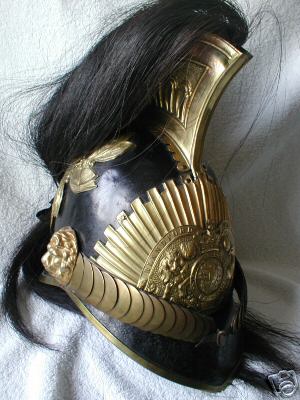


 0
0 -
Stuart, thank you for the comments. I do see the pith style helmets from time to time and will watch for the rubber or cork spacers.
Michael
0 -
Found an image of the 42nd with the double breasted tunic and the Crimea medal. So, will have to do more research on the Long Service and who might have received one in the 1854-1860 period.
Michael
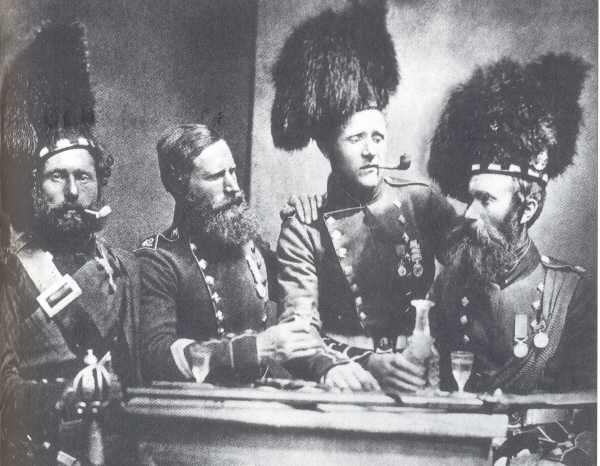
 0
0 -
I have added the full image of the 42nd as there might be other details to confirm whether the full uniform suggests 1856.
Michael
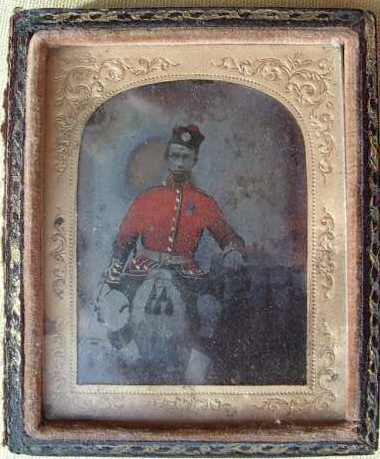
 0
0 -
Eric:
If I recall correctly, the Crimea medals were first shipped to the Crimea in 1855. The image of the 42nd above shows a no clasp medal which appears to be the Long Service Good Conduct, which was issued to McNab in May, 1854 just before the Regiment left for the Crimea. I don't think this is an image taken while in the Crimea so that eliminates June to December of 1854, all of 1855 and to the middle of 1856 when the Regiment returned to the UK. As McNab was discharged in 1857 there is a very small window for the image to have been taken. For this to be McNab (who was the only decorated other rank in 1854) it must be either May 1854 before the Regiment left for the Crimea or sometime after and before he received his second medal, the Crimea. If the jacket is 1856, then I am not sure why it does not show both the earlier Long Service medal and the new Crimea medal. Bit of a puzzle.
I think I will go back and double check how many of the 42nd would have a Long Service Good Conduct medal during the period 1854 to 1860.
Michael
Thank you Stuart.
0 -
The type of process used and how the image was prepared might affect how colours are represented. If the image of the soldier in the light jacket is an "ambrotype" vs an image on paper, then it is my understanding that a dark jacket might appear light. See below:
"The ambrotype is actually a glass negative that, backed with a dark material, appears to be a positive. The milky collodion highlights (that would appear black in a modern negative) are light and the unexposed dark areas show the dark backing to provide the shadows.With ruby glass ambrotypes the dark red glass acts as the backing.Introduced in 1854, they were easier and cheaper to make than daguerreotypes. Ambrotypes were presented in the same style of bindings and cases as were daguerreotypes and replaced them in the 1850s.
A well made ambrotype may be a striking image but lacks the depth of a well made daguerreotype.
On the right is a 1/4 plate ambrotype by Mathew Brady. It is housed in a "flip case" where the image can be viewed from either side with the brown velvet on the inside of the covers serving as the dark backing. In the image on the far right we have placed a white card half way into the case to show the negative/positive effect."[end quote]
While it appears that the jacket in our image is light (too many ofher details are right -see hands), the above merely indicates that these types of images are dependent on how the image was prepared for presentation.
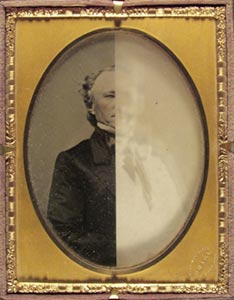
 0
0 -
Stuart:
Do you find that a particular type of head dress suffers more or less from tampering or "additions".
Michael
0 -
Eric:
In trying to id my image, I was able to work with the medal. It was felt this might be a pre-Crimea image as he is wearing a Long Service Good Conduct medal and information provided showed that there was only one decorated other rank of the 42nd immediately prior to the Crimea and in this time period:
Private D. McNab, 42nd Royal Highlanders
Crimea 1854-56, 1 clasp, Balaklava (846, 42nd Royal High?s.), regimentally engraved; Army Long Service and Good Conduct, V.R., large letter reverse, with steel clip and straight bar suspension (846 Pt., 42 R.H.), engraved, very fine. Private D. McNab enlisted into the Royal Highlanders on 13 August 1835 and was discharged 11 August 1857. His L.S. & G.C. was issued 11 May 1854 with a gratuity of ?5. McNab was also entitled to the clasp for Sebastopol.
Assuming it is McNab, it was thought that an image post 1855/56 should show both the Long Service and the Crimea and given that McNab was discharged in August 1857, the window of when the image would have been taken would be any where from 1854 when the Long Service was issued to prior to issue of Crimea to members of the 42nd. If the uniform is 1856, as you note, then we would be trying to find members of the 42nd not in the Crimea with a long service in the mid to late 1850s. Otherwise, we have McNab just before his Crimea was issued.
Re the photos above, it is not unlikely that person producing the image might have taken some liberty in presenting the image. For instance, in the McNab image I was advised "the image is a reverse one (look at the buttonholes)...it looks all right at first glance, as the medal was changed sides for the purpose of the photography - a common trick of the trade with 'types'." You can also see where the "buttons" were added.
Also, would the type of image process be relevant - for example would a red show as a lighter colour so that the man on the right is wearing something other than a white jacket.
Michael
0 -
Here is the interior:

 0
0 -
Thank you Stuart. More economical to start with the book. Here is an example to the 3rd Dragoons that is described as being a P1881. Shows the interior as well as the side. Should the "ear bosses" be closer to the facing of the helmet? This example shows the black background missing from the earlier example:
Michael

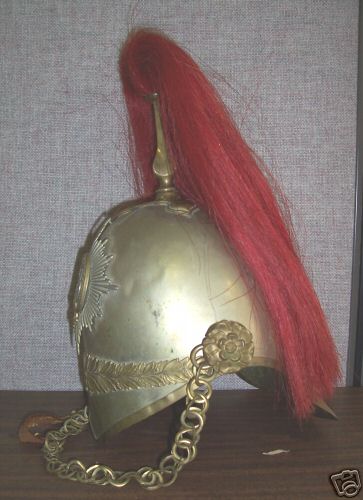

 0
0 -
Thank you Stuart. There is a book that I see from time to time: Head Dress of the British Heavy Cavalry by David JJ Rowe. Is this worth the price or are there better references.
Michael
0 -
Here is a 42nd pre-Crimea. Similar badge shape as the man on the right.
Michael
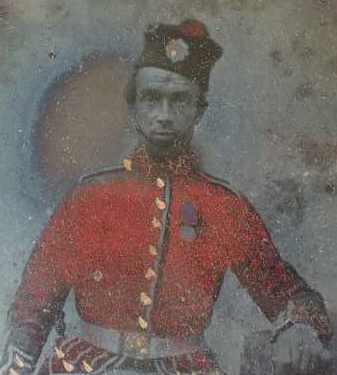
 0
0 -
Below is an image I have of a group of Officers and Other Ranks of the Royal Artillery and Royal Horse Artillery, which I believe to be from the late 1850s perhaps early 1860s. Don't know if this helps Leigh or you with the id of the man on the left. If it is of the same time period, you man does not appear to match up with the RHA men in the image.
Michael

 0
0 -
Leigh:
I am always looking for something to illustrate a medal or something related and find these postcards and other early print material as being one way to do it. You have a number of nice cards in your collection and was wondering if you have anything early that depicts cavalry from Waterloo, the Crimea or Indian Mutiny. Did Payne or one of the others do a series?
Michael
0 -
Also, as it would be easier for me (and perhaps others) to research British Regular Army, my main focus would be on Regular Army vs militia.
Thank you in advance for any comments.
Michael
0 -
In looking at Stuart's collection, it seems to me that it might be useful to have a discussion on early British helmets. Although I have yet to jump into another area of collecting, I do collect cdvs and cabinet cards and have always thought about having one or two examples to compliment these images. Problem is, that they seem to be higher priced items and short of buying from a UK auction house, the only other source is one of the online auction sites. However, on these sites you can never be sure if you are buying an old badge on a new helmet or one of the many reproduction helmets.
It would also be interesting to match up these helmets with period images although I appreciate that anything earlier than the late 1850's would be difficult.
To, hopefully, start the ball rolling, the following is a being sold as a Pattern 1871 Other Ranks helmet of the 1st (Royals) Dragoons, a heavy cavalry regiment. It is ebay item 260101607574. Can anyone confirm details and what might be a reasonable price range for a helmet like this. Seems to be in very good condition.
Thank you.

 0
0


Troopship Photos
in Great Britain: Militaria: Badges, Uniforms & Equipment
Posted
Boer War Example 2: